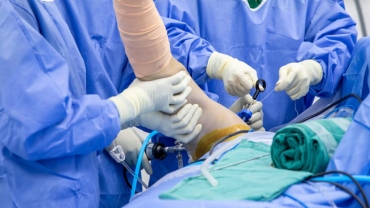Arthroscopic wrist surgery is a minimally invasive surgery that may accelerate an injured athlete’s return to sports participation or general recovery for non-athletes. The value of wrist arthroscopy as a minimally invasive means of diagnosis and treatment is clear for a wide range of wrist injuries and conditions.
Diagnosing Wrist Conditions
The wrist connects the hand to the forearm and is made up of small bones, joints, tendons and ligaments. A wide range of injuries and conditions can cause wrist pain. Stress on the wrist from repetitive motion is often the cause of discomfort. Wrist pain may be accompanied by bruising, clicking, swelling, misshapen joints and/or a lack of mobility. Your physician will ask you about your symptoms, followed by a physical examination, and may order diagnostic testing like x-rays or an MRI to diagnose the wrist condition.
Who Needs Wrist Arthroscopy?
Many wrist injuries will respond well to conservative treatments like rest, pain medication, or physical therapy. But, when conservative measures don’t work, wrist arthroscopy may be an effective way to assess and treat wrist pain and conditions. A patient may undergo arthroscopic wrist surgery for any of the following reasons:
- To assess pain in the wrist ligaments, cartilage, and bones.
- To study and treat ligament and cartilage tears, and support complex fracture management.
- To detach loose bones or cartilage.
- To review and remove built up scar tissue that can limit movement.
- To take out ganglion cysts.
Advantages of Wrist Arthroscopy
As a minimally invasive procedure, there are various advantages of arthroscopic surgery over traditional surgery:
- Less scarring and a lower infection rate from smaller surgical incisions
- Quicker recovery and less pain due to smaller cuts
- Easier to assess the condition of ligaments, tissues and cartilage
- Quicker return to full mobility following surgery
- Challenging everyday tasks are easier to do
- A brief hospital or outpatient stay
The procedure is typically performed in an outpatient facility using regional anesthesia which insures the hand and arm will be numb and the patient will not be able to feel any pain during the procedure. Through the arthroscope, that allows access to the joints in the wrist using several small incisions, the joint is visualized using a very small camera with an image projected onto a television monitor. The arthroscope inserted into the joints can be used as diagnostically to detect damaged tissues or for minimally-invasive treatment of the joints, ligaments and cartilage structures.
Post surgery, stitches are used to close the incisions and a dressing is applied to keep the wounds clean. A splint may sometimes be used to stabilize the wrist joint and promote healing. Athletes can quickly return to sports as they experience less post-operative pain and the healing time is substantially less.
Arthroscope also helps in the reduction of wrist fractures. Any tears to the central part of cushioning cartilage structure within the wrist joint can be treated with arthroscopic treatment, wherein this cartilage disc is smoothed, and irritating flaps are removed. Arthroscopic surgery also helps repair any peripheral tears too.
Patients can typically go home on the same day as the procedure. Open surgery procedures can take up to three months for full recovery but with wrist arthroscopy the recovery is within four weeks. Patients are recommended formal physical, occupational and/or hand therapy after any type of arthroscopic wrist procedure to guide them with wrist exercises at home through the rehabilitation process. Most therapists will initially prescribe wrist strengthening exercises, range of motion (ROM), grip and pinch exercises to reduce pain, stiffness and swelling. This will slowly start to include returning to full physical activity and work demands.
Post-Operative Care:
Depending on the type of injuries or conditions being treated the recovery time can range from several days to several weeks or months.
After wrist arthroscopy, your physician will likely use a protective bandage, sling or splint to wrap your wrist.
Your physician may also prescribe the RICE regimen for the first two or three days following surgery: rest, ice, compression, and elevation (keeping the wrist above heart level to reduce swelling and pain).
Keep all your surgical incisions covered, clean and dry following the procedure and avoid showering until the surgical dressings are removed and replaced with a waterproof covering.
Outside of your prescribed therapy regimen, without the doctor’s go ahead do not use the operative wrist for any activities involving pushing, pulling, twisting or lifting.
Let the expert surgeons at IBJI help you determine if arthroscopic surgery is the right step for you. At IBJI, you will have all your needs cared for, before, during, and after arthroscopic operations.




